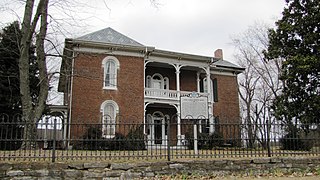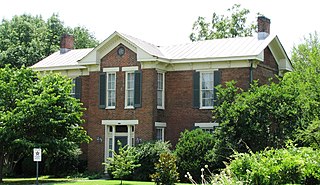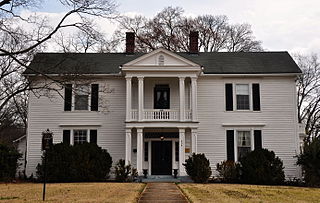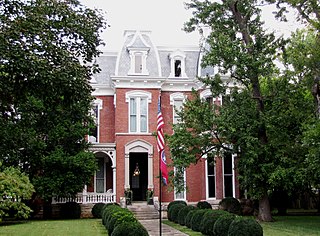
Ross Winn was an American anarchist writer and publisher from Texas who was mostly active within the Southern United States.

The Boyce-Gregg House is a historic house in Memphis, Tennessee, U.S..

The James R. DeBow House, also known as Vinewood, is a historic house in Hartsville, Tennessee, U.S.. It was built from 1854 to 1870 for James R. DeBow, who inherited the land from his father. The house was designed in the Italianate architectural style. During the American Civil War of 1861–1862, the partially completed house was used as a hospital for the Union Army. By the late 1800s, it was purchased by merchant James R. Andrews, followed by Noel Coleman Winston in 1904. It has been listed on the National Register of Historic Places since November 3, 1988.

The Dr. John Owen Campbell House is a historic house in Lebanon, Tennessee, U.S.. It was built from 1841 to 1843 for B. W. G. Winford. It was designed in the Greek Revival architectural style. It remained in the Winford family until 1906, when Winford's son-in-law, B. F. Lester, sold it to Dr. John Owen Campbell, the son of Tennessee Governor William Bowen Campbell. It was later acquired by Herbert C. Ruck. It has been listed on the National Register of Historic Places since December 8, 1980.

The Fite-Fessenden House is a historic house in Lebanon, Tennessee, U.S.. It is now home to the Wilson County Museum.

Camp Bell is a historic house in Lebanon, Tennessee, U.S.. It was built circa 1835 for William Seawell. It was designed in the Greek Revival architectural style. It was later purchased by the Campbell family, whose son, William B. Campbell, became the 14th Governor of Tennessee; he later died in the house. It remained in the family; by the 1982, it was owned by his great-granddaughter, Mary Williamson Thomas. It has been listed on the National Register of Historic Places since April 15, 1982.

The McNutt-McReynolds House is a historic house in Maryville, Tennessee, U.S..It was built circa 1900 for Robert G. McNutt, a merchant. It was designed in the Queen Anne architectural style. It was purchased by J. A. Reynolds in 1906, and by Dr. W. B. Lovingood in 1920. It has been listed on the National Register of Historic Places since July 25, 1989.

The Frierson-Coble House is a historic house in Shelbyville, Tennessee, U.S.. It was built in 1835 for Erwin J. Frierson, who was trained as a lawyer by James K. Polk, who went on to serve as the 11th President of the United States from 1845 to 1849. Frierson served as a member of the Tennessee House of Representatives in 1845. In 1888, the house was purchased by Dr Neely Coble, a physician; it was later inherited by his son, Thomas Coble, also a physician. By the 1980s, it still belonged to the Coble family. It has been listed on the National Register of Historic Places since April 12, 1982.

The Brame-Reed House is a historic house in Shelbyville, Tennessee, U.S.. It was built circa 1840 for Melchisedec Brame, a farmer from Virginia who owned 9 slaves. Brame died in 1845, and in 1850 a portico designed in the Greek Revival architectural style was added by his heir, William B. M. Brame. Shortly after, the house was purchased by L. C. Reed. By the 1870s, it was purchased by John Cotner, and it remained in the Cotner-Wood family until the 1980s. It has been listed on the National Register of Historic Places since January 23, 1998.

The Absalom Lowe Landis House, also known as Beech Hall, is a historic house in Normandy, Tennessee, U.S..

The John Green Sims House is a historic house in Wartrace, Tennessee, U.S..

The Nathan Bedford Forrest Boyhood Home is a historic log house in Chapel Hill, Tennessee, U.S.. It was the childhood home of Confederate General and Ku Klux Klan leader Nathan Bedford Forrest from 1830 to 1833. It is owned by the Sons of Confederate Veterans.
Ewing Farm is a historic farmhouse three miles away from Lewisburg, Tennessee, US.

Idler's Retreat, also known as the Dillon-Tucker-Cheney House, is a historic house in Smyrna, Tennessee, U.S.. It was built circa 1865 by J. D. Dillon. In 1882, it was purchased by John F. Tucker, and renamed Tucker Place. It was designed in the Greek Revival and Italianate architectural styles. By the 1940s, it was inherited by Brainard Cheney's wife. The couple entertained other writers like Robert Penn Warren, Caroline Gordon, Flannery O'Connor and Allen Tate. The house was later inherited by Roy Neel, who served as the chief of staff to Vice President Al Gore. It has been listed on the National Register of Historic Places since May 19, 2004.

The Collier-Crichlow House is a historic house in Murfreesboro, Tennessee, U.S..

The Collier-Lane-Crichlow House is a historic house in Murfreesboro, Tennessee, U.S.. It was built circa 1850 for architect Sterling P. Jones, who designed in the Federal, Georgian and Greek Revival architectural styles. It was purchased by brothers Jessie A. Collier and Newton C. Collier in 1858. Four of Murfreesboro's mayors from the Collier-Crichlow family lived in the house: Ingram Collier, Newton B. Collier, James H. Crichlow Jr., and N. Collier Crichlow. It was restored by new homeowners in 1975. It has been listed on the National Register of Historic Places since August 23, 1978.

The Logan Henderson Farm, also known as Farmington, is a historic farm house in Murfreesboro, Tennessee, U.S.. Built as a slave plantation in the Antebellum South, it later became a dairy and cattle farm. It is now a horse farm.

The Sperry-Smith House is a historic house in Sparta, Tennessee, U.S..

The Childress-Ray House is a historic house in Murfreesboro, Tennessee, U.S.. It was built in 1847. In 1874, it was purchased by John Childress, the brother of U.S. First Lady Sarah Childress Polk, brother-in-law of U.S. President James K. Polk, and the father-in-law of Tennessee Governor John C. Brown. Former First Lady Sarah Polk was a frequent visitor.
Greenfield, also known as the David Chenault Home, is a historic farmhouse in Castalian Springs, Tennessee, U.S..


















